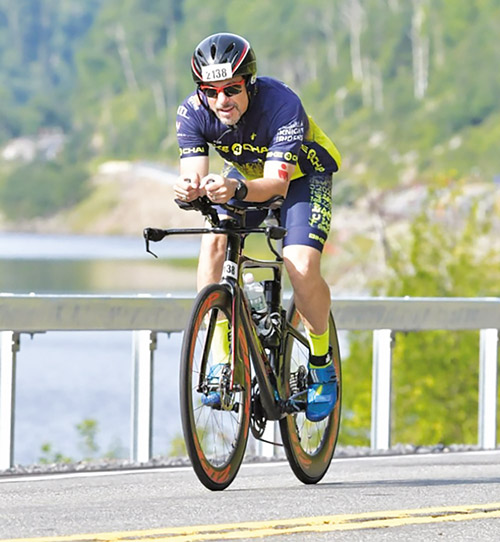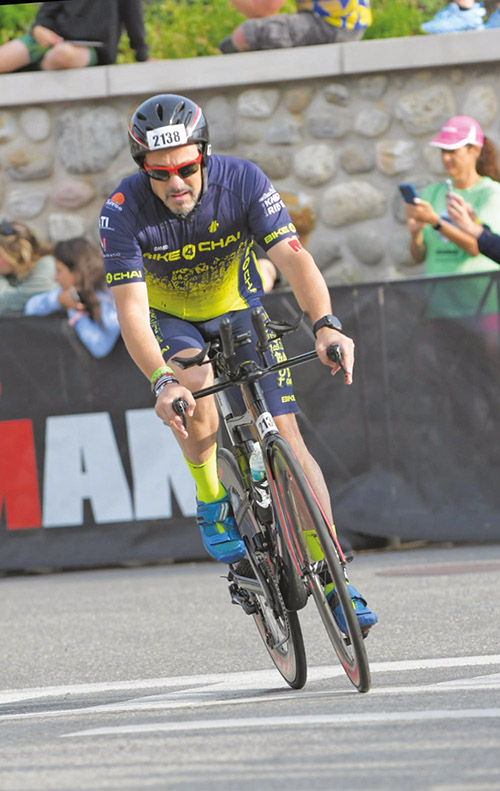
8:11 a.m. (1 hour and 32 minutes since race start)
I wanted my computer spitting back data like an infant with pureed peas by the time I put tires to asphalt and I got it.
I climbed on my bike seat and slid my feet into my bike shoes.
(What do you mean “slid” your feet into your bike shoes? Weren’t you wearing them?)
No, I had clipped them onto the bike when I pumped up the tires. I’ve had too many bike starts where I stood there trying to clip my shoes in. The first half mile of the bike course was a series of winding downhills.

(Huh?)
Think slalom skiing.
(Yikes!)
Yeah, it was go fast, brake and turn, go faster, brake and turn again.
For a mile and half I was cruisin’.
Then after two miles, the hills kicked in.
This is where experience paid off.
This was my fifth time racing Ironman Lake Placid. I knew this course like I lived on those streets.
(What does that mean?)
I knew every turn, every rise and fall of the course. Every tree lined street and every horse farm I would be passing…
(Real horses?)
No, big wooden ones, built by the Greeks that Paris warned the Trojans not to bring into their city. Yes, real ones. The danger is to stare at them. If you take your eyes off the road you might veer onto the grass and even crash.
(So … kinda like the Trojan Horse. Disaster would strike,)
It means that when my pace dropped from 15 miles per hour to six miles per hour at mile two, I knew the road would flatten out at mile five and I’d get my momentum back.
(So?)
So, I wouldn’t push super hard on this section to keep going at 15 miles per hour.
It meant that at mile 10, when I hit over 40 mph going down a mile and half long descent called Keene, that I wouldn’t have to pedal for the next five miles.
It meant that when I finished loop one, I wouldn’t have to.. but I’m getting ahead of myself.
The first loop seemed to go by quickly.
(Yeah, if you can call 3.5 hours on the bike quickly.)
It felt that way. I had strength in my legs and the sun warmed my face. It was the warmth one feels in the first days of spring, before the humidity kicks in. The warmth that generations of Jews from NYC sought summer after summer as they escaped to the Adirondacks or the Catskills for the summer. I had to keep reminding myself to drink in this “warmth.” I had three bottles on my bike: protein shake, Gatorade and water. The protein shake gave me calories to burn, the Gatorade electrolytes to replace what I was sweating out and water for hydration.
Gatorade was created in 1965 at the request of Florida Gators football coach Ray Graves.
Gatorade was created to help athletes by acting as a replacement for body fluids lost during physical exertion. The earliest version of the beverage consisted of a mixture of water, sodium, sugar, potassium, phosphate and lemon juice.
(Why does my body need phosphate?)
Phosphate is used as a building block for cell energy.
(Yeah, that does seem important. What about potassium?)
Potassium is an essential mineral that carries a small electrical charge. That charge activates various cell and nerve functions.
(That also seems important.)
Without these two ingredients your body will not be able to complete 140.6 miles of swimming, biking and running. You might actually die trying.
Originally, Gatorade came in two flavors: lemon lime and orange.
(Yuck.)
Yea, I’m partial to blue raspberry, because that flavor was never kosher on anything when I was growing up in the mid 70s. The point is when you sweat, you lose water and sodium. When you exercise, you burn carbohydrates. Gatorade replaces all of those. Now, Gatorade isn’t the only drink that does this, but it fits three criteria for me:
1. It’s kosher.
2. I like the flavors (most of them).
3. It’s easily available.
I was averaging 17.5 mph on the bike instead of my normal 14 mph. I seemed to be flying from checkpoint to checkpoint on the course.
(Check points?)
The final climb before the descent back into town where the bike section ended was called “the three bears.” It’s a series of difficult climbs.
In 2016, I had to get off my bike and rest there because my heart rate was too high.
In 2019, I was so tired that my pedaling was slower than my run.
On this day, I sailed up all “three bears.” The climb was so easy that I was shocked at how quickly I had arrived.
(Settle down Beavis, there’s another 56-mile loop to complete.)
12:43 p.m. (5 hours since race start)
At the end of the first loop is a choice, go left or go right.
(Morphius’s red or blue pill?)
Left was for bike dismount and the start of your run.
Right was for the second loop.
David Roher is a USAT certified triathlon and marathon coach. He is a multi-Ironman finisher and veteran special education teacher. He is on Instagram @David Roher140.6.
He can be reached at [email protected].








